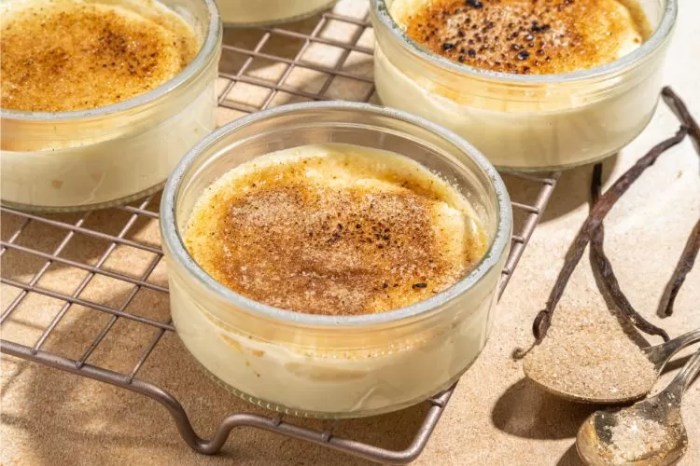
Crab brulee recipe – Discover the tantalizing world of crab brulee, a delectable dish that combines the savory flavors of crab with the rich, creamy texture of brulee. Dive into this culinary adventure as we explore the origins, preparation, variations, and pairings of this extraordinary dish.
From its humble beginnings to its newfound popularity, crab brulee has captivated taste buds with its unique and harmonious blend of flavors. Let’s embark on a journey to uncover the secrets of this culinary masterpiece.
Introduction

Crab brûlée is a luxurious and decadent dish that combines the delicate flavors of crab with the creamy richness of a custard. Its origins can be traced back to the French countryside, where it was traditionally made with fresh crab caught from the Atlantic Ocean.
Over the years, crab brûlée has gained immense popularity worldwide, becoming a staple in fine dining restaurants and a favorite among seafood enthusiasts.
Popularity
The popularity of crab brûlée stems from its unique combination of flavors and textures. The tender crab meat provides a delicate and briny base, while the creamy custard adds a velvety richness. The caramelized sugar topping adds a delightful crunch and a touch of sweetness, creating a harmonious balance of flavors.
Additionally, the dish is visually appealing, with its golden-brown crust and vibrant orange filling.
Ingredients and Preparation
The crab brûlée requires a few key ingredients to create its distinctive flavor and texture.
To begin, you’ll need fresh crab meat. It’s recommended to use lump crab meat for the best results. Additionally, you’ll need heavy cream, eggs, Dijon mustard, grated Parmesan cheese, salt, and pepper.
Preparation
- Preheat your oven to 350°F (175°C).
- In a large bowl, combine the crab meat, heavy cream, eggs, Dijon mustard, Parmesan cheese, salt, and pepper.
- Mix well until all ingredients are evenly combined.
- Pour the mixture into individual ramekins or a small baking dish.
- Bake for 20-25 minutes, or until the custard has set.
- Let cool slightly before serving.
Variations and Modifications

Crab brûlée offers a canvas for culinary creativity, allowing for numerous variations and modifications to cater to diverse preferences and flavor profiles.
Crab Type and Flavors
The choice of crab is a key factor in shaping the taste and texture of the brûlée. While blue crab is commonly used, experimenting with different types of crab, such as Dungeness or king crab, can yield unique flavor combinations.
Additionally, incorporating additional flavors into the custard base, such as herbs (e.g., chives, parsley), spices (e.g., paprika, cayenne), or citrus zest (e.g., lemon, lime), can enhance the overall taste experience.
Craving a taste of the wild? Try the chicken of the woods recipe ! This unique mushroom resembles chicken in texture and flavor, making it a delightful vegan alternative. With its vibrant orange color and earthy aroma, this delicacy will tantalize your taste buds.
Dietary Adaptations
To accommodate dietary restrictions or preferences, modifications can be made to the recipe. For a gluten-free version, substitute the all-purpose flour with gluten-free flour. To reduce fat content, use low-fat or nonfat milk instead of whole milk. For a vegetarian or vegan alternative, replace the crab with finely chopped mushrooms or tofu, and use a plant-based milk (e.g.,
almond milk, soy milk).
Serving and Presentation
Crab brûlée is a versatile dish that can be served in a variety of ways. Traditionally, it is served warm or at room temperature, in the ramekins in which it was baked.
For a more elegant presentation, you can unmold the crab brûlée onto a serving platter and garnish it with fresh herbs, such as chives or parsley. You can also drizzle it with a lemon-herb sauce or a balsamic reduction.
Plating Techniques
If you want to get really creative, you can try plating the crab brûlée in different ways. For example, you could pipe it into small cups or molds, or you could spread it out on a plate and use a cookie cutter to create fun shapes.
Pairing and Accompaniments

Let’s explore the ideal accompaniments and wine pairings to enhance the delightful experience of crab brûlée.
When it comes to selecting a wine that complements the delicate flavors of crab brûlée, white wines with crisp acidity and a light to medium body are recommended. Consider pairing your crab brûlée with a glass of Sauvignon Blanc, Pinot Grigio, or Chardonnay.
Looking for a nutritious and flavorful addition to your meals? The chicken of the woods recipe has got you covered. This mushroom is packed with antioxidants and minerals, making it a healthy choice for any diet. Whether you sauté it, grill it, or roast it, this culinary gem is sure to impress.
Potential Accompaniments, Crab brulee recipe
To further elevate the dish, consider serving crab brûlée alongside a fresh and vibrant salad. A simple arugula salad with a lemony vinaigrette or a light fennel salad with a citrus dressing would provide a refreshing contrast to the richness of the brûlée.
Additionally, roasted vegetables such as asparagus or baby carrots can serve as a flavorful and healthy accompaniment.
Final Summary
As we bid farewell to our exploration of crab brulee, let us remember its versatility and ability to tantalize our senses. Whether enjoyed as a sophisticated appetizer or an elegant main course, this dish leaves a lasting impression on all who indulge in its delectable flavors.
Embrace the culinary artistry of crab brulee and create your own unforgettable dining experiences.
FAQ Insights: Crab Brulee Recipe
Can I use different types of crab for this recipe?
Yes, you can use various crab varieties such as Dungeness, blue crab, or king crab, depending on your preference and availability.
How do I achieve the perfect golden-brown crust on top?
Before placing the brulee under the broiler, sprinkle a thin layer of granulated sugar evenly over the surface. Use a kitchen torch to caramelize the sugar, creating a crisp and flavorful crust.
What are some suitable wine pairings for crab brulee?
Consider pairing crab brulee with a crisp Sauvignon Blanc or a light-bodied Chardonnay to complement its delicate flavors.





